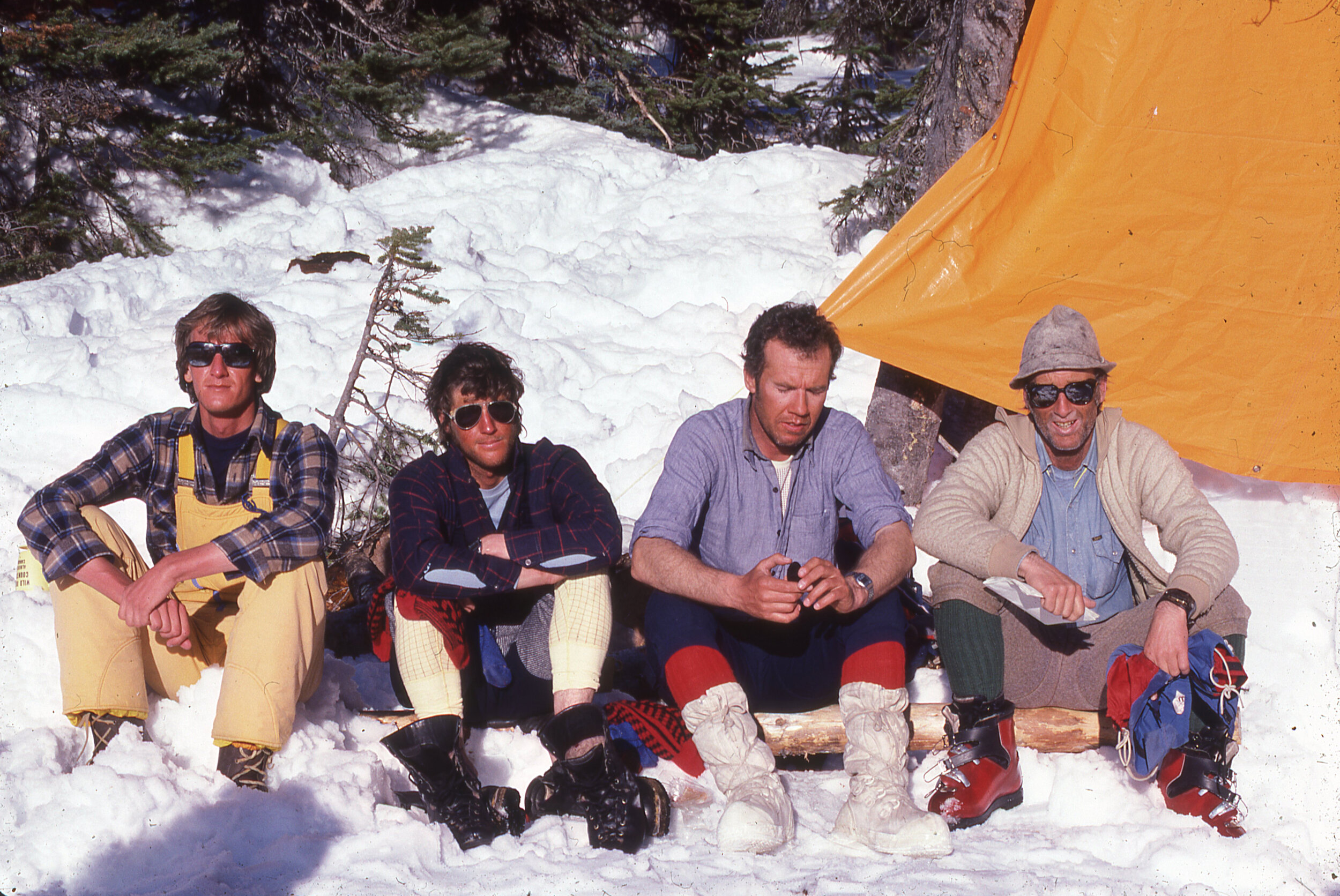BERNIE SCHIESSER: MASTER OF THE HILLS
By Lynn Martel
Bernie Schiesser calls it fate, but the cast of characters in his bio reads like a who’s who of Rockies history. Over the course of his long life, Schiesser’s positive energy and remarkable contributions to many aspects of mountain life have firmly established him on that same roster. Here’s the story behind the man – the pioneer, guide, and backcountry host – who will forever have a legacy in the Canadian Rockies.
Bernie Schiesser at Campbell Icefield Chalet. Photo by Bruce Roberts.
“Bernie Schiesser,” says long-time friend Randy Heppell, “taught me how to pace myself. Working, logging, skiing or just walking in the mountains, life became a meditation. He was always trying to get me to find that focus, that energy that put me in tune with what I was doing and the environment around me.”
FARM LESSONS
Born in 1937 in Creston, B.C., Schiesser grew up just outside Golden, B.C., where his family settled a large tract of land where he still lives today. Farm life taught him simplicity and old-fashioned hard work. And toughness. From grades one through four, his commute to school was the real deal, walking for two miles on a bush trail to the one-room country school, sometimes through metre-deep snow.
“During the 1940s it was bloody cold,” Schiesser recalled. “Not just because we were kids, but the old days were colder than now. We had those little ink pots – they’d be frozen solid in the morning.”
At home he joined his seven siblings chopping wood, milking the cows, feeding the chickens and pigs and tending to the large vegetable garden. In those days, the farm, he said, was everything. Schiesser, however, found a little extra value in his chores by following his curiosity, a life-long trait that served him well.
“I would help my father with butchering,” he described. “You learn a lot about anatomy from butchering. The liver, the heart, you see what the organs look like inside the animal and you can go from there to what’s inside you. I was always interested in looking and learning.”
At home in the mountains. Photo by Rod Plasman.
Joy in learning earned him four scholarships, so he attended the University of British Columbia in Vancouver. City life, he decided, was not for him, so after a year he returned to the mountains where opportunity and lessons were as abundant as the peaks. In the mid-1950s he worked with the team surveying the Trans-Canada Highway over Rogers Pass, riding the train to work. He worked various logging jobs, where his on-the-farm anatomy lessons paid off when he took an industrial first aid course.
Climbing mountains, however, was in his soul; his Swiss-born father met his mother in Calgary through the Alpine Club of Canada (ACC). He learned at a young age and joined his father on climbs and exploratory bushwhacks into the nearby Purcell Mountains. Neighbour Ken Jones, the first Canadian-born mountain guide, dropped by to share stories and pointers. Young Bernie was all ears.
LEADING INTO THE FUTURE
Schiesser’s education outdoors was diverse. One summer he worked with the wardens in Yoho National Park. They were good horsemen and solid outdoors people whose company he really enjoyed. They gave him a horse and sent him to be the summer warden at Ice River cabin where the ACC was running its annual camp. And one winter he worked in Rogers Pass helping avalanche safety legend Noel Gardner develop a program to protect the new highway, gaining experience that taught him a healthy respect for the power of snow and avalanches.
In 1962, Schiesser’s first aid skills led him to ski patrol work at Lake Louise, where he accepted a Swiss co-worker’s invitation to climb the new Red Shirt route on Mount Yamnuska. His first technical climb was an eye-opener, and they followed up with Diretissima two weeks later.
Soon he was at Lake O’Hara, working as a rescue warden and climbing on his days off with Rockies masters of the time, including Brian Greenwood. He partnered with author Sid Marty (back then a warden) for the first ascent of the Takakkaw Falls rock route. He even helped on the famous rescue of Greenwood and Charlie Locke on the East Face of Babel, orchestrated by rescue pioneer Walter Perren. When Perren ran his warden climbing school in the fall, Schiesser was his youngest student.
“The other wardens, they were cowboys,” Schiesser recalled. “Some of them were really competent, really tough old goats, like Billy Vroom. Some of them were nervous, even on just the standard route on Victoria. At the warden school, Walter got me to do all the dirty stuff. Like, well, ‘we’ve got to do crevasse rescue, so Bernie, we’ll send you down, we’ll rescue you.’ That was neat, getting to know Walter. I was fortunate, over the years, to meet some amazing people. Just fate, I guess.”
From left, ACMG mountain guides Phil Hein, Rudi Kranabitter, Ferdl Taxbock and Bernie Schiesser debrief after completing the Cariboo ski traverse on the spring ski guide exam, circa 1980. Photo courtesy Rudi Kranabitter.
By 1967, Schiesser passed his guides’ exam with the young Association of Canadian Mountain Guides, examined by ACMG founders Hans Gmoser, Peter Fuhrmann, Hans Schwartz and Leo Grillmair. His career was launched. He and fellow ACMG guide, John Gow started High Horizons summer camp for teens. Gow stepped back after losing a foot in a plane crash, but for 13 summers Schiesser ran the camp, making first ascents with teenagers in Kananaskis Country.
“Every time we did a new route or a first ascent we made sure it was with the kids, which was sort of our policy,” Schiesser described. “You get some, 16-, 17-, 18-year-olds, they’re pretty competent. If you have them for two weeks, the second week you can do damn near anything with them.”
Among those teenagers was Diny Harrison, who, in 1992, became the first female ACMG-certified mountain guide. Over time, however, being responsible for the kids twenty-four-seven, for two straight months, added up.
“It was a lot of pressure that way,” Schiesser admitted. “But it was the most enjoyable thing I’ve ever done, and the most satisfying thing I’ve ever done.”
Bernie in the heli. Photo by Bruce Roberts.
His next pursuit brought different pressure. Having worked for Mike Wiegele Helicopter Skiing as an instructor for four years, Schiesser launched his own business. Staging from the Spray Lakes Dam, they skied the Burstall area, Ribbon Creek, the Royal Group and Palliser Pass, and when conditions allowed, Sparrowhawk, a 1400-metre “good run.” But at $40 a day, the enterprise didn’t stay airborne. He guided for other heli-ski operations and ran ACC trips, teaching avalanche safety and crevasse rescue courses during which he’d often demonstrate his formidable igloo-building skills. Serving as ACMG president from 1977 to 1983, he guided Alberta Premier Peter Lougheed up Mont Lougheed in 1980 with fellow guides Lloyd “Kiwi” Gallagher and legendary photographer Bruno Engler for the province’s 75th anniversary. Using his logging skills, he ran a forest-reduction project in Banff’s Middle Springs, where Randy Heppell first met him.
“Bernie worked like ten bears and had us all working like rented mules,” Heppell said. “He taught me to use positive energy rather than negative. The negativity just turns a learning process into an argument and then nothing you say or do will help the issue. His motivation strategy was always positive reinforcement. And we all wanted to give him 100 per cent every day.”
BACKCOUNTRY LEGACY
In 1982, Schiesser and fellow ACMG guide Eric Lomas built the ACC’s Neil Colgan Hut. They followed it with Peter and Catharine Whyte (Peyto) Hut, the Freshfields, Lloyd MacKay (Mount Alberta), and Scott Duncan huts, establishing the Schiesser-Lomas and Schiesser Ledges access routes along the way. In 1986 he earned his pilot’s license and began flying his Piper Arrow over the mountains in search of the perfect location for a backcountry lodge. He eventually chose a high meadow in the western Rockies, 40 kilometres north of Golden.
“I flew all over the Rockies and the Purcells and the Selkirks looking for a place,” he recalled. “That’s when I found Campbell Icefield, around ’87. Every year the snow was never out of there before July. You could ski right to the front door.”
When Parks Canada decided to decommission the Freshfield hut, Schiesser and Lomas flew the just five-year-old modular structure in pieces to the Campbell site and began inviting their friends to come skiing. Then they got to work building the larger, modern and comfortable Campbell Icefield Chalet, which they opened in 2003.
Bernie & Terri Schiesser. Photo by Bruce Roberts.
Now in his early 80s and officially retired from guiding, Schiesser runs the lodge with Lomas’s two sons, Chris and Andre, and is an enthusiastic member of the Backcountry Lodges of British Columbia Association. He divides his time at home with his wife of four decades, Terri (they tend to a spectacular vegetable garden), and at the lodge, skiing his favourite lines and sharing stories with his guests.
It’s the people, he declares, that he loves as much as the wilderness landscape.
“I like the non-mechanized type of client, or person, because they have that same interest you have; they just love being up in the mountains,” Schiesser said. “And Campbell is about as nice as any place you’ll find. You become friends in a week with a lot of people, and they’re good people. And that’s nice.”
For Heppell, who worked as an ACMG ski guide for years, the lessons he gained from Schiesser are as rich as the adventures he shared with his friend and mentor.
“Find peace in a pace,” Heppell said. “As a guide, Bernie taught me to always be patient and kind, and to find meditation in everyday tasks. I will forever be an apprentice to Bernie, a master of the hills.”
Campbell Icefield Chalet.
Brought to you by:







